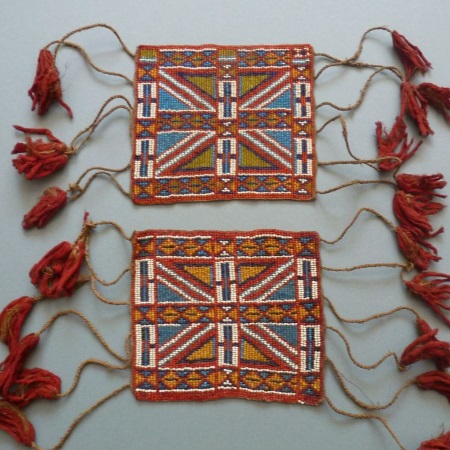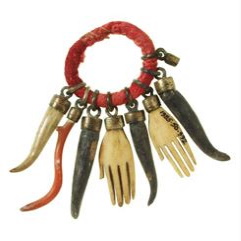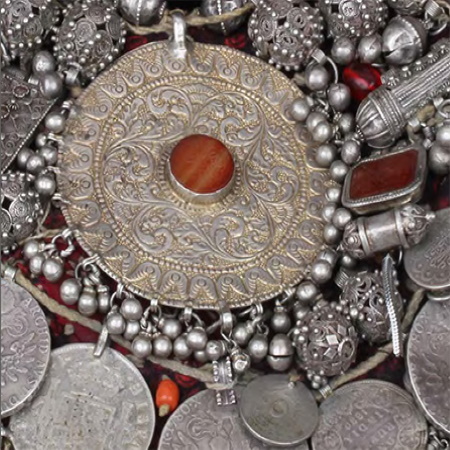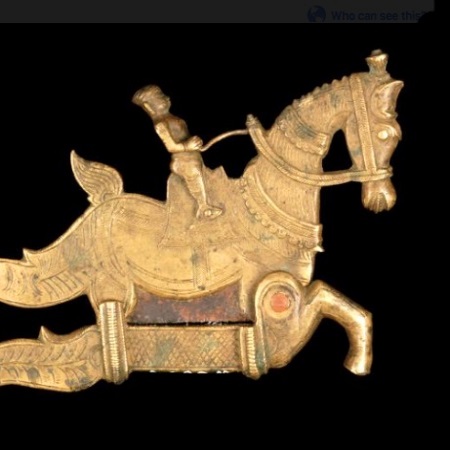A guide to identification by Sarah Corbett
Many materials have been sold throughout the years with the name tag ‘Amber’.
In this article we shall look at some of them and use some sleuthing skills to identify them!
True Amber can be pressed, heat treated and dyed, so although shape and colour can be an indicator, alone they are not conclusive.
Lots of tests exist:
THE SCRATCH TEST
does the material scratch with a pin?
THE SALTWATER TEST
Add 7 heaped teaspoons of salt to 250 ml of cold water stir the solution occasionally over 30 minutes until dissolved. Does the materail float?
THE ALCOHOL TEST
A drip of alcohol is applied to the material. Allow the alcohol to evaporate. If the substance is sticky at the point of contact with the alcohol it is not Amber.
THE SIMICHROME TEST
An unreliable but often quoted test using polish, which lifts dye from Bakelite products, however it also lifts dyes from some other plastics and polyesther.
LIGHT TEST
Amber Fluoresces..amber from different regions shines in it’s own particular way..
SMOKE TEST
Amber – Gives a black smoke which smells of pine
Copal – Gives a white smoke which smells of pine
Plastic gives a black smoke which smells chemical
Please always be wary of plastic fumes! They can be unhealthy!
So how can we observe, and methodically appraise a material to understand its origins..
Key to identifying fake amber
1. Can the beads be scratched with a pin?
Yes. Amber or plastic. Go to 4.
No. They are also heavy and cold to the touch. Glass or semi-precious stones. Go to 2.
2. Are the beads identical in colour and shape? (They can be different sizes).
Yes. Glass.
No. Go to 3.
3. Are the beads striped?
Yes. Agate.
No. Probably chalcedony. An orange/red form of chalcedony is called Carnelian.
4. Can you see separate chips of amber within the material?
Yes. Polybern – amber chips embedded in polyester resin. Usually the resin is transparent and amber-coloured, but opaque white or black resin has also been used. Where the maker has been mean with the use of amber chips, the chips are only found on one side.
No. Go to 5.
5. Do the beads float in a saturated salt-water solution (see above)?
Yes. Amber or polystyrene. Go to 6.
No. Plastic. Go to 11.
6. Are the beads transparent/translucent or opaque?
Transparent/translucent. Go to 7.
Opaque. Go to 8.
7. Do some of the beads have bulbous centres to the string holes?
Yes. Polystyrene.
No. Amber. The beads may contain inclusions such as small insects, bark fragments and oak hairs (only visible with a hand lens). Oak hairs are a good indicator of Baltic amber. If the beads contain spangles (circular cracks) then they have been heat-treated. Old beads may be crazed (fine surface cracks).
8 Is every bead identical in shape? (They can be different sizes).
Yes. Amber or polystyrene. Go to 9.
No. Amber.
9. Do the beads contain dark swirls?
Yes. Polystyrene.
No. Amber or polystyrene. Go to 10.
10. Are the beads different shades of colour?
Yes. Amber.
No. Polystyrene or amber. It is rare to get every bead of opaque amber the same shape and colour. Old amber can be crazed (fine surface cracks), though polystyrene can be coated with acetate which cracks and can peel off in places.
11. Are the beads transparent/translucent or opaque?
Transparent/translucent. Go to 12.
Opaque. Go to 14.
12. Do some of the beads have bulbous centres to the string holes and/or mould lines along the beads?
Yes. Acrylic.
No. Go to 13.
13. Do the beads contain spangles (circular cracks) or deep surface cracks?
Yes. Polyester.
No. Probably Bakelite, though could be acrylic, celluloid, polyester or another plastic. Bakelite beads, mostly made in the 1920s and 1930s can be either smooth or faceted, and are usually oval, spherical or barrel-shaped. Red is the most common and popular colour, but other colours also exist. Other similar beads of other plastics also exist.
14. With a hand lens, can you see machine lines around the beads and fine crazing?
Yes. Galalith. This is a rare early plastic made from casein (milk protein) and formaldehyde. The necklaces we have seen are a dirty greenish/yellow colour.
No. Go to 15.
15. Does it contain swirls?
No. Probably Bakelite, or celluloid.
Yes. Go to 16.
16. Can you see mould lines around the beads?
Yes. Acrylic.
No. Bakelite, acrylic, polyester or another plastic.
Tags: a guide to identify amber, how to identify amber, identification of Amber, imitiation amber






